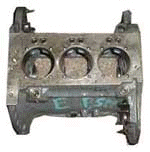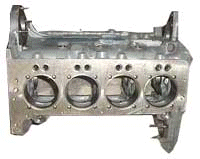|

Ca
Ch
Ci
Cl
Co
Cr
Cu
Cy
|
Caliper
The apparatus on disc
brakes
which hold the disc pads and straddles the disc. When actuated the
pads press against the disc to stop or slow the vehicle.
|
 |
Cam
[1]
A designed bump on a shaft or disc which causes a rocking motion in
an adjacent part.
[2]
A metal disc with irregularly shaped lobes used in the camshaft
to activate the opening and closing of the valves and in the
distributor, to force the points to open.
[3]
A colloquial name for the camshaft.
[4]
A name for the breaker
cam.
cam
lobe
cam
lobes The
bumps on a cam
that contact and activate such devices as the lifters, which operate
the valves, and the rubbing block, which causes the points to open
and close, as the cam spins with the distributor shaft.
Camshaft
A rotating shaft on which a series of cam
lobes operate
the valve mechanisms. The camshaft may be driven by gears, by
sprockets and chain or by sprockets and a belt.
Canister
A container in an evaporative emission control system; contains
activated charcoal granules to trap vapors from the fuel system.
Carburation
Carburetion
The mixture of vaporized fuel and air in the proper proportions
for combustion in an engine
Carburetor Optionally
spelled "carburetter" or "carburettor."
|
A
device that vaporizes fuel and mixes it with air in proper
quantities and proportions to suit the varying needs of the engine. A
filter screens the air which is drawn into the carburetor. Here the
gasoline mixes with the air and this fuel vapor enters the combustion
chamber through
the intake
valve where it
is compressed and burned. |
 |
Carburetor
Kit A set of gaskets and parts necessary to rebuild a carburetor.
Castor
In wheel alignment, the backward or forward tilt of the steering
axis. Castor is positive when the steering axis is inclined rearward
at the top.
Catalytic
converter A silencer-like device in the exhaust system which
converts certain pollutants in the exhaust gases into less harmful substances.
Chain Drive
The driving of one shaft by another by means of a toothed wheel on
each shaft, with the wheels connected by an endless chain with
special links engaging the teeth.
Chassis
The
basic-strength auto frame including the engine, suspension, wheels,
brakes and drive train. A car without its body or coachwork. In
monocoque or unit construction it is integral with the body.

'Check
engine' light 
Almost
all modern vehicles have a computer to control the operation of the engine
and transmission
(sometimes it is called Powertrain
Control Module
[PCM] or Electronic
Control Module
(ECM) or something alike). There are also various sensors all over
the engine and transmission (such as coolant temperature sensor,
speed sensor, exhaust oxygen sensor, airflow sensor, etc.) that give
input to the computer. Using this input, the computer maintains the
highest engine efficiency with the lowest possible emissions. When
the signal from any of the sensors is wrong or beyond the limit, the
computer lets you know by turning the "check engine" light
on. It can mean anything: broken sensor wire, loose connection, bad
gasoline, clogged fuel injector, bad catalytic converter, etc. Most
often it's related to the emission control components. On newer cars
the 'check engine' light will come on even if you simply forget to
close the gas cap. If the "check engine" light is on, this
means the computer has stored the trouble code(s) in its memory. The
trouble code points to the defective part. All you need to do is have
a dealer scan the vehicle computer with a diagnostic scanner and get
this code. The code will show exactly what's wrong, or at least will
give the technician the direction where to look for.
Choke
A
mechanism, either manual or automatic, whose purpose is to supply an
enriched fuel mixture to a carbureted engine to aid in cold starting.
It effectively reduces the amount of air allowed into the intake
manifold through the carburetor.
A
temporary restriction in a carburetor throat that reduces the flow
of air and enriches the fuel-air mixture to aid in starting the engine.
A
butterfly valve or plate located near the top of the carburetor that
limits or restricts the amount of air allowed to enter the
carburetor, thus enriching the fuel-air mixture and enabling the
vehicle to start and run more easily when cold. Automatic chokes have
a thermostatic coil or thermostatic spring that activates a butterfly
valve at the top of the carburetor barrel. Older cars have manually
operated chokes. Some vehicles use an enrichner instead of a choke.
Circlip
A ring-shaped clip used to prevent endwise movement of cylindrical
parts and shafts. An internal circlip is installed in a groove in a
housing; an external circlip fits into a groove on the outside of a
cylindrical piece such as a shaft.
Cluster
Panel The
reverse side of the instrument panel or dash where all the wiring or
circuit board is located.
|
Clutch
A drivetrain component that connects an engine to a manual
transmission and is used to engage transmission gears. It also allows
the transmission to be |
 |
disconnected
from the engine, so the vehicle can sit still with the engine
running. A clutch is a friction mechanism that typically consists of
a disc and pressure plate assembly. To engage the clutch, the driver
simply applies pressure to the clutch pedal. The linkage from the
pedal to the clutch can be mechanical or hydraulic.
|
Clutch
Plate The clutch plate is a thin, steel, disc whose center is
connected to the transmission input shaft by a grooved piece of
metal, or hub. The disc is covered with material that is similar to
the break linings. This material allows the clutch to slip smoothly
and quietly. |
 |
Coil
See ignition coil
Coil
Spring
|
[1]
A section of spring steel rod wound in a spiral pattern or shape.
Widely used in both front and rear suspension systems. Like large
metal bed springs, these coils cushion and absorb the shocks and
bumps as the |
 |
vehicle
is driven. They are usually found near the front wheels, but some
cars have them in the rear as well. Often the shock absorbers run up
the center of the coil springs.

[2]
A coiled metal spring used in a suspension fork. Generally
considered to be plusher, but heavier, than air springs.
A
spiral of elastic steel found in various sizes throughout a vehicle,
for example as a springing medium in the suspension and in the valve train.
Combustion
The intense burning of the fuel-air mixture in the combustion
chamber. Some used to think that the fuel-air mixture exploded; but
further investigation has shown that it rapidly burns. Also see
combustion chamber volume, combustion chamber, combustion space,
compression ignition, controlled combustion system, external
combustion engine, fireball combustion chamber, hemispherical
combustion chamber, internal combustion engine, main combustion
chamber, pent-roof combustion chamber, pre-combustion chamber, and
wedge combustion chamber.
Combustion
Chamber The space remaining at the top of the cylinder
when the piston
is at the top
dead center position. Where the fuel-air
mixture begins to burn.
The
volume of the space in the cylinder above the piston with the piston
at top dead center (TDC) in the compression
stroke. The head of the piston, the
cylinder walls, and the head form the chamber. Combustion of the
fuel-air mixture begins here when ignited by a spark
plug. The design and shape of the
combustion chamber can affect power, fuel efficiency, and emissions
of an engine.
Combustion
Chamber Recess The area where combustion
occurs in a rotary
piston engine
Combustion
Chamber Volume volume of combustion chamber (space above piston
with piston on TDC) measured in cc (cubic centimetres).
Combustion
Engine: See external
combustion engine and
internal combustion engine
Combustion
Pressure: The pressure created during the combustion of the
air/fuel mixture in the cylinder, measured in pounds per square inch.
Combustion
Residue: Carbon and other deposits resulting from combustion.
Combustion
Space See combustion
chamber.
Compression
[1]
Applying pressure to a spring, or any springy substance, thus
causing it to reduce its length in the direction of the compressing force.
[2]
Applying pressure to a gas, thus causing a reduction in volume. [3]
One of the essential factors in a internal
combustion engine (fuel, air, proper
proportion of mixture, compression, timing, spark). It is the
squeezing of the fuel-air
mixture in the cylinder
of a spark-ignition engine or the squeezing of the air in a diesel
engine. Compression makes the process
of combustion
more effective and increases engine efficiency.
Read
More about Compression within the Car Engine
Compression Ratio
The
ratio of the cylinder volume with the piston at bottom dead center
to the cylinder volume with the piston at top dead center.
Connecting
Rod The arm that connects the piston
to the crankshaft
and converts the reciprocating
motion into rotary motion.


Discover
How The Connecting
Rod
works in The Engine
Constant
Velocity (CV) Joint A type of universal
joint that cancels out vibrations caused by driving power being
transmitted through an angle.
Control
Arm A front suspension component that often is shaped like the
letter A and also may be called an A-arm. Two points on the control arm
|
(at
the "bottom" of the A) attach to a vehicle's frame, while
the third point attaches to the spindle. Rear control arms feature a
different design but accomplish essentially the same purpose.
Both types of high-performance control arms are designed to eliminate
flex, which leads to more predictable and improved handling, as well
as enhanced traction capabilities. |
 |
Some
rear control arms are adjustable, as well, to allow for adjustments
to the vehicle's suspension geometry.

Coolant (antifreeze)
is a complex chemical liquid helps prevent freezing in cold
climates, so that cars can operate in sub zero temperatures, and
boils at a higher temperature than water. Besides this, it also
lubricates the water pump as it flows through. Some antifreeze
compounds are specially formulated for aluminum radiators. Keep the
coolant somewhere between 20 and 60 percent of the mixture in your
car, depending on the car and climactic conditions. Do not use a
strong antifreeze mixture as it can cause leaks in your car's cooling
system. Coolant is extremely poisonous and should be handled with
care. If it spills on the ground it can kill stray animals that drink it.
|
Most commercially available antifreeze contains ethylene glycol, a
chemical that helps to control the temperature of the water in a
vehicle’s radiator. During its life in a vehicle, antifreeze may
become contaminated with fuel or heavy metal particles and grit. If
the levels of dissolved metals, such as lead or cadmium, are high
enough, used antifreeze may be a hazardous waste.
Do not dispose of antifreeze down the drain, in sewers, or into
streams. Never drain the antifreeze from your car onto the street.
The sweet smell of antifreeze is appealing to dogs and cats, who may
drink it. Antifreeze is poisonous to animals — even a small
amount can kill them.
CHEMICAL CONSTITUENTS: Ethylene glycol, Lead, Toluene
Here are some waste reduction tips:
Reduce the amount of antifreeze you use by routinely checking the
radiator, reservoir, and hoses for leaks and repairing them immediately.
Avoid overfilling the radiator or reservoir.
Extend preventive maintenance (PM) cycle. As long as a chemical
analysis or an antifreeze tester reveals that your antifreeze is
doing its job, don’t drain and replace it.
Do not drain antifreeze into the street, into storm drains, or onto
the ground.
Use dedicated equipment and containers to collect and store used
antifreeze to avoid contamination.
Recycle used antifreeze by sending it off-site for recycling, or
contracting with an on-site recycling service. Specify a totally
enclosed system. |
Cooling
Fan
[1]
A large fan designed to suck relatively cool air and force it onto a
warm object like an engine.
[2]
A large fan designed to pull away the radiant warm air surrounding a
hot object.
Cooling
Fins:
The greater the surface area that needs to be cooled, the better you
will be able to cool off a hot object, like an engine. By putting a
number of fins on a surface, you increase the overall area. On air
cooled engines, for instance, you will see a series of closely formed
ridges or fins in parallel. As the air passes by them, the engine
heat is dissipated.
Cooling
Jacket
See water jacket
Cooling
System After a vehicle's engine comes up to operating
temperature, its thermostat
opens and the water pump
begins to circulate coolant
through the vehicle's engine block
and out to the radiator.
This helps to maintain the engine at an optimal temperature and
prevent overheating.
A
cooling system requires regular
maintenance. Typically, the fluid
must be drained, and some automakers recommend
flushing the system, as well.
Refer
to the owner's manual for more details.
Core
Plug A disc or cup-shaped metal device inserted in a hole in a
casting through which core was removed when the casting was formed.
Also known as a freeze plug or expansion plug.
|
Corvette
A vehicle, Chevy brand of which the 1953-70 models are milestone
cars.
Corvette
debuted in January of 1953 as a show |
 |
car
in the GM Motorama. It was a stylish two-seat convertible, designed
to show the world that GM could create a sports car to compete with
European nameplates like Jaguar and MG. All 1953 Corvettes were Polo
White with red interiors.
Cowl
That part of a car's body between the engine compartment and the driver.
C-Pillar
C
Pillar The body post that supports the rear of the roof
and to which the left and right sides of the back glass are attached.
Also
called "C-post."
C
Post
C-Post
see C-pillar
Crankcase
The
lower part of the engine block
in which the crankshaft
rotates. A pan
or box that encloses the bottom of
the engine,
supports the crankshaft, and contains the oil
for the engine.



Crankshaft
The main shaft of an engine
with a U-shaped offset at each cylinder
to which the connecting
rod is attached. It delivers rotary
motion taken from the reciprocating pistons
and connecting rods.

Discover
How The Crankshaft works in The Engine
Crocodile
Clip See Alligator
clip
Cubic Capacity
The
volume of the cylinder between the piston top dead center and bottom
dead center. Expressed in cubic centimeters or cubic inches.
Cubic Centimeter
(cc) European, metric, and competition measure of engine displacement:
1,000
cc = 1 liter, which equals about 61 cubic inches.
Cubic Inch
(cu. in.) U.S. measure of engine displacement:
1
cubic inch = 16.387 cc.
Cylinder
The round chamber or hole in the cylinder
block that houses the pistons
and where combustion
takes place. Also called "bore" or "barrel."
|
A
device which converts fluid power into linear mechanical force and
motion. This usually consists of movable elements such as a piston
and piston rod,
plunger or ram, operating within a cylindrical bore. |
 |
Discover
How The Cylinder
works in The Engine
Cylinder Block
The
basic framework of the engine
to which other engine parts are attached. It is usually a casting and
includes the engine cylinders
and the upper part of the crankcase.
See
image above
Cylinder Head
The
detachable part of the top of the cylinder
block
that contains the spark plugs
and valves. It
seals the cylinder
and forms the top of the combustion
chamber.
See
image above

A
B
C
D
E
F
G
H
I J
K
L
M
N
O
P
Q R
S
T
U
V W
X
Y
Z |
|